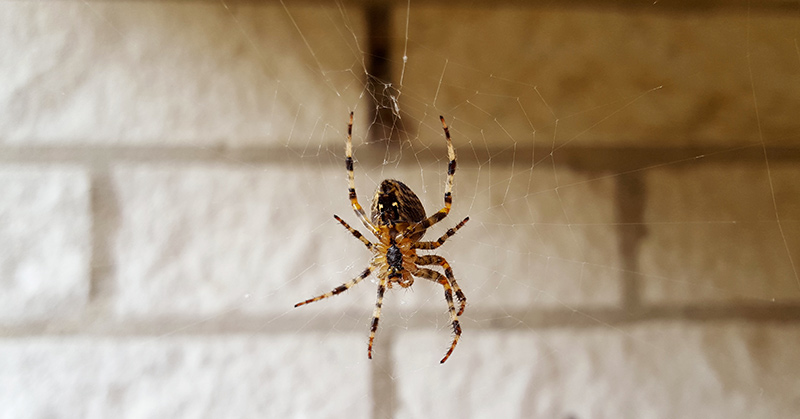When comic book writer Stan Lee proposed the idea of Spiderman, his publisher thought this superhero was going to be a disaster. “Stan,” he said, “that is the worst idea I have ever heard… People hate spiders, so you can’t call a book Spider-Man.” [1]
While that is definitely true, Spiderman was met with mass approval and adoration. Spiders themselves not so much. Arachnophobia, the fear of spiders, affects more than one in ten people in the USA. [2] There’s something about their erratic movements and their strange ‘legginess.’ Also, many of them are venomous and people fear being bitten (unless they really love Spiderman.)
The fall is prime time for spider home invasions. There are arachnid-killing products available but they often contain questionable ingredients and are usually expensive. Many people prefer more old-fashioned techniques, such as the cup and paper trap, the boot, or the good old ‘scream until someone kills the spider for you.’
Fortunately, there are some natural, inexpensive, – and much less stressful approaches available.
The Natural Spider Repellent
Two words: peppermint oil.
Spiders and insects can’t stand the smell of mint. Spreading the scent around the house is one way to encourage these arachnids to either leave or never show up in the first place. It’s a lot more humane than the boot and will skirt the problem of a child crying because “you killed Spidey!”
Now, in all honesty, there’s not a lot of scientific evidence behind the claim that peppermint oil repels arachnids; in fact, commercial pest control companies actively dispute this concept. However, anectoally, there are many cases where peppermint oil did help get rid of spiders, enough that it’s probably worth a try, especially if you already love the aroma of mint.
One theory why spiders hate mint is that they dislike strong scents. These creatures smell and taste with their legs and they’d prefer not to walk through essential oils. Another theory, according to a 2010 study, is that the monoterpenoids in these oils act as natural fumigants. [3] Virtually all essential oils contain monoterpenes.
How to Make DIY Peppermint Oil Spider Repellant
CAUTION: Peppermint and other mints are toxic to dogs and cats. Do not use around pets.
Step 1: Place about five drops of peppermint oil into a 16-ounce spray bottle.
Step 2: Fill the rest of the bottle with water, and add a dash of natural dish soap.
Step 3: Shake the bottle until the mixture is combined.
Step 4: Spray the repellant around doors, windows, and any corners where spiders may be lurking.
You may have to reapply the spray more often than conventional brands. Try once a week and see if that solves the problem, and spray every few days if needed. [4]
Safety Note for Peppermint Oil
Peppermint oil is safe in small doses. It contains menthol, which can cause skin irritation for those sensitive to it. The National Association for Holistic Aromatherapy warns that inhaling large doses of peppermint oil can cause muscle weakness, dizziness, confusion, nausea, and double vision. The risk of these symptoms increases if you spray a lot of undiluted peppermint oil in a closed area. The formula for the spider repellant lowers this risk, but use caution nonetheless. Avoid spraying the entire house, and keep the windows open to allow fresh air in. [5]
If peppermint isn’t your thing, or you find it’s not working as well as you’d hope. Here are two other honorable mentions when it comes to kicking the 8 legged critters to the curb.
DIY Garlic Spider Repellant
Step 1: Smash five cloves of fresh garlic and place them in a spray bottle.
Step 2: Add two cups of water.
Step 3: Allow the garlic to steep for a few hours before use.
Step 4: Spray around spider-infested areas, like doors, windows, and outside.
This natural spray can act as an alternative to pesticides for gardens and it can help remove spiders — and vampires — from the home as well. [6]
Recipe Credit: Mrs. Happy Homemaker
DIY Tomato Leaves Spider Repellant
Step 1: Blend a handful of tomato leaves with two cups of water and 1 teaspoon of cornstarch in a food processor until combined.
Step 2: Pour the mixture into a spray bottle and apply the repellant where needed.
Cornstarch can suffocate insects that interact with it, and tomato leaves have been studied and found to repel spiders and reduce their laid eggs. [7]
Whichever repellant you prefer, good luck with keeping your home arachnid-free this season!
Recipe Credit: Mrs. Happy Homemaker
Use Caution With Pets
As previously mentioned, mint is dangerous for dogs and cats [8]. Unfortunately, both the tomato plant [9] and garlic [10] are toxic to cats and dogs as well. While ingesting these oils and plants are different than smelling or coming into contact with the spray, it is probably best to err on the side of caution and to avoid their use around pets. If you are unsure please consult with your vet.
Sources
- Nolan Feeney. How Spider-Man Was Born https://time.com/4117869/stan-lee-spider-man-creation/ November 18, 2015
- Chris Buddle. Why Are We So Afraid Of Spiders? https://www.independent.co.uk/life-style/health-and-families/features/why-are-we-so-afraid-of-spiders-10263450.html May 20, 2015
- Ayvaz Abdurrahman Insecticidal Activity of the Essential Oils from Different Plants Against Three Stored-Product Insects https://www.ncbi.nlm.nih.gov/pmc/articles/PMC3014752/#!po=85.2941
- Annette McDermott. Peppermint Oil and Spiders: Know the Facts https://www.healthline.com/health/healthy-home-guide/peppermint-oil-spiders#research November 21, 2016
- NAHA. Safety Note for Peppermint. https://naha.org/index.php/naha-blog/peppermint-safety-info/ December 23, 2013
- Crystal. DIY Natural Spider Repellent https://www.mrshappyhomemaker.com/diy-natural-spider-repellent-3-ways/
- GF Antonious. Repellency and oviposition deterrence of wild tomato leaf extracts to spider mites, Tetranychus urticae Koch. https://www.ncbi.nlm.nih.gov/pubmed/26079341 2015
- ASPCA. Mint. https://www.aspca.org/pet-care/animal-poison-control/toxic-and-non-toxic-plants/mint
- https://www.aspca.org/pet-care/animal-poison-control/toxic-and-non-toxic-plants/tomato-plant
- https://www.aspca.org/pet-care/animal-poison-control/toxic-and-non-toxic-plants/garlic

